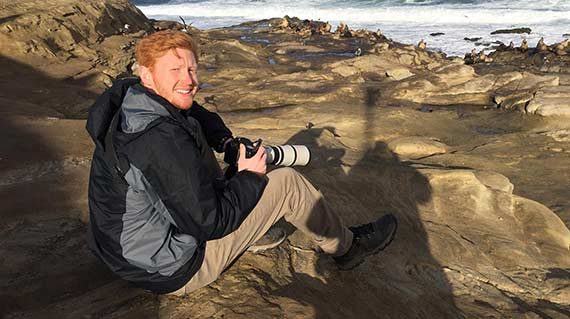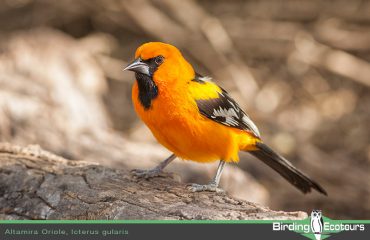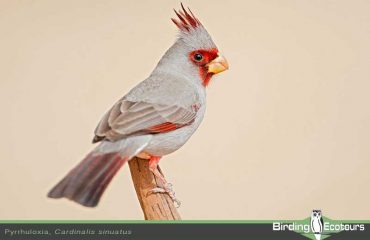
Your Guide: Jacob Roalef
Tours: Alaska, Arizona, California, Colorado, Florida, Maine, Minnesota, Ohio, Texas, Wyoming, Birding Ecotours (Worldwide)
Texas needs no introduction. The “Lone Star State” covers a vast area of the southern US, and incorporates a wide mix of habitats ranging from pinewoods and marshes along its eastern border with Louisiana, through to deserts and arid shrublands characteristic of America’s southwest (reminiscent of Arizona), and the verdant riverine woodlands of the Rio Grande Valley, a prelude to what lies further south in Mexico. The phrase, ‘everything is big in Texas’ holds true – Houston, San Antonio and Dallas-Fort Worth are some of the largest and most populous cities and metropolitan areas in the country, and the state is also home to one of the largest national parks in the country – Big Bend National Park (we arrange private tours here in the spring/summer, to look for the rare Colima Warbler – please specifically ask us about this!). The official bird list of the state, true to form, is also massive – numbering well over 650 species – which is a significant portion of the total species within the US.
This short tour, timed at the start of winter, sees us focusing on the many resident specials of the state, and in particular, trying to find as many of the Mexican/Neotropical species as possible. Indeed, a great deal of bird species can only be reliably found in Texas, within the US. First and foremost is Whooping Crane. This species has a tragic history, having been on the verge of extinction with fewer than 20 individuals left in the wild, before a great rehabilitation and reintroduction program was set in motion. With non-stop work over decades, this species has been down-listed to Endangered by the IUCN Red List, and now some 300+ individuals survive in the wild. This is an important target for us on this tour, and we dedicate time around Corpus Christi, at the start of this tour, where we can access the Aransas National Wildlife Refuge, specifically targeting this highly sought-after species.
Following on, this tour ventures into the Lower Rio Grande Valley, where a number of days are spent exploring the excellent and vast network of state parks, preserves and wildlife areas. This wild part of the state supports a range of species more typically found further south in Mexico, and indeed the Neotropics. Perhaps no better example of this exists with the fact that Ocelot occur in the area, though a great deal of luck is needed to see this secretive and rare cat. A wide range of species will be targeted, including such charismatic species as Plain Chachalaca, Aplomado Falcon, Ringed Kingfisher, Golden-fronted Woodpecker, Green Jay and Long-billed Thrasher. We will also make a special effort for rare species like Morelet’s (White-collared) Seedeater, and will keep an ear to the ground for any rarities that may be present in the area – which may include such sought-after species as Northern Jacana and Crimson-collared Grosbeak. In addition, a number of waterbirds will be seen, everything from spoonbills to pelicans and curlews, and a number of species more regularly associated with the drier American southwest, such as Greater Roadrunner and Black-throated Sparrow, should also feature.
The tour is limited to 8 participants, or on rare occasions to 10 participants, in which case we will have a second tour leader and van.
Duration: 9 days
Limit: 4 – 8
Date: 03 December – 11 December 2026
Start: Corpus Christi, Texas
End: Corpus Christi, Texas
Price:
US$4,123 per person sharing assuming 4 – 8 participants
Single supplement: US$689
We can run the same trip at a price similar to the larger group price for 2 tour participants, if they rent their own vehicle and pay for fuel – please e-mail [email protected] for details.

Tours: Alaska, Arizona, California, Colorado, Florida, Maine, Minnesota, Ohio, Texas, Wyoming, Birding Ecotours (Worldwide)
SOUTH TEXAS & the LOWER RIO GRANDE VALLEY TOUR:
13-22 February 2015
Top 10 lists are voted upon by the participants at the completion of each tour.
1 – White-collared Seedeater
2 – Gray-crowned Yellowthroat
3 – White-throated Thrush
4 – Ferruginous Pygmy-Owl
5 – Common Pauraque
6 – Greater Roadrunner
7 – Clay-colored Thrush
8 – Gray Hawk
9 – Burrowing Owl
10 – Green Jay
While watching flocks of Green Parakeets in the northern part of McAllen, we saw an intriguing sight. A PURE YELLOW Green Parakeet was flying with a flock of approximately 25 normally colored parakeets. We had never seen anything quite like it. A possible explanation can be found at this link: https://en.wikipedia.org/wiki/Xanthochromism. There was a hybrid oriole coming to a feeder at Bentsen-Rio Grande Valley State Park. One of its parents was almost certainly an Altamira Oriole. The other parent species has yet to be determined.
After great looks of two Greater Roadrunners, someone asked ‘Where is Wile E. Coyote?’ A Coyote appeared seconds later! Unusually uncommon on this tour, we saw just one Collared Peccary (Javelina) as we were driving. Alligator Lake at Estero Llano Grande State Park contained five American Alligators. We saw one snake on the entire tour, a Diamondback Water Snake at Bentsen State Park. Also at Bentsen was a Texas Gopher Tortoise, often known as Berlandier’s Tortoise. We identified nearly 20 species of butterflies on this winter tour, including prolonged scope views of the spectacular Mexican Bluewing. Its range barely extends north into the Lower Rio Grande Valley.


 Piping Plover
Piping Plover
 Sandwich Tern
Sandwich Tern
 White-tailed Hawk
White-tailed Hawk
 Northern Beardless-Tyrannulet
Northern Beardless-Tyrannulet
 Olive Sparrow
Olive Sparrow
 Green Kingfisher
Green Kingfisher
 Green Jay
Green Jay
 White-throated Thrush
White-throated Thrush
 Blue Bunting
Blue Bunting
 Clay-colored Thrush
Clay-colored Thrush
 Clapper Rail
Clapper Rail
 Altamira Oriole
Altamira Oriole
 Audubon's Oriole
Audubon's Oriole
 Crested Caracara
Crested Caracara
 Vermillion Flycatcher
Vermillion Flycatcher
 Great Kiskadee
Great Kiskadee
 Gull-billed Tern
Gull-billed Tern
 Red-crowned Parrot
Red-crowned Parrot
 Common Tern
Common Tern
 Common Pauraque
Common Pauraque
 Golden-fronted Woodpecker
Golden-fronted Woodpecker
 Plain Chachalaca
Plain Chachalaca
 Elegant Trogon
Elegant Trogon
 Eastern Screech-Owl
Eastern Screech-Owl
 Common Ground-Dove
Common Ground-Dove
 Ladder-backed Woodpecker
Ladder-backed Woodpecker
 Groove-billed Ani
Groove-billed Ani
 Greater Roadrunner
Greater Roadrunner
 Pyrrhuloxia
Pyrrhuloxia